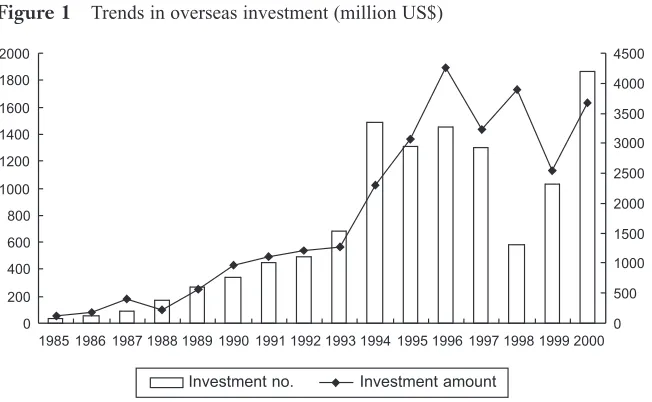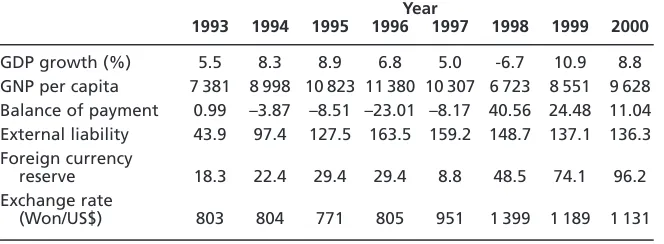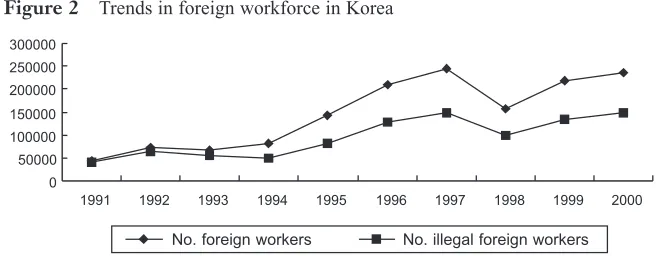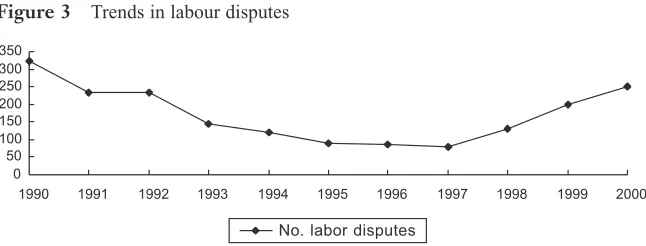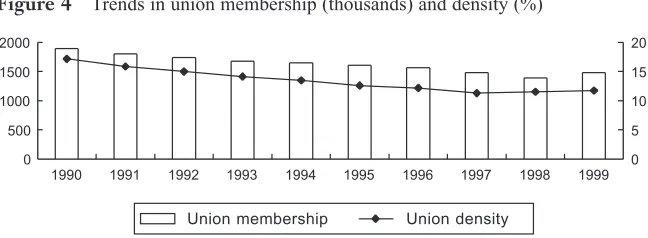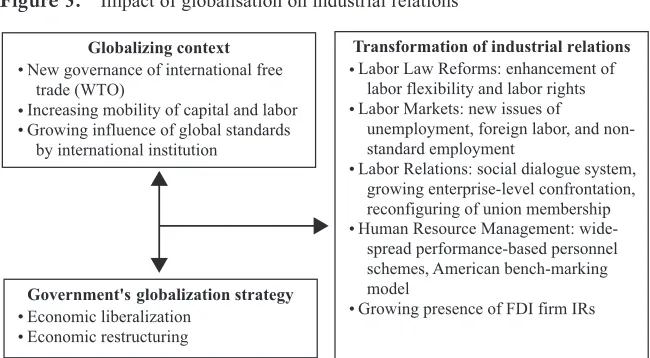E
RA OF
G
LOBALISATION
WON-DUCKLEE* ANDBYOUNG-HOONLEE**
G
lobalisation has influenced the transformation of Korean industrial relations by manifesting itself in the government’s globalisation strategy and neo-liberal restructuring policies. Global market competition and international labour standards have been the key reference criteria used by the Korean government and other concerned parties to reform labour laws. Under the reality of globalisation and economic crisis, labour has been increasingly disadvantaged, with workers having experienced not only growing job insecurity, accompanied by high unemployment and deteriorated employment status as demonstrated by the sharp rise of non-standard workforce, but also widening income inequality. The Korean government’s effort to build a tripartite partnership as part of its strategic response to globalisation and the economic crisis has been constrained by the process of labour law reform and economic restructuring. At the same time, the pressure of globalisation has led to the instability of labour relations at the enterprise level by producing intense labour-management confrontations concerning employment adjustment and corporate restructuring. HRM schemes of Korean companies have to a large extent shifted to the performance-based system as a result of managerial efforts to respond to growing global competition and to benchmark global best practices.INTRODUCTION
From the 1960s to the 1980s, Korea achieved ‘compressed’ economic growth by resorting to export-oriented industrialisation (EOI) policy led by the develop-mental state. During this period, despite the country’s heavy dependence on international trade, the government pursued economic liberation in a gradual and selective way in order to protect the domestic market and regulate capital mobility across the border. However, the government began to take a variety of active policy measures to become a winner of the globalisation era from the early 1990s.
In this vein, globalisation has had a profound impact on Korean industrial relations as well as other areas of the society over the last decade. The effect of globalisation on industrial relations in Korea can be conceived as being two-fold—that is, the reality of environmental pressure and the government’s policy agenda.1 On the one hand, globalisation, having been promoted by
the new order of international free trade, transnational capital mobility, and breakthroughs in information-communication technology (ICT) during the 1990s, has challenged Korea’s national economy with increasing competition in both the domestic and overseas markets as well as with a growing influence of foreign capital. On the other hand, globalisation has been the primary focus of the Korean government’s policy agenda, which it has strategically pursued in order to enhance the competitiveness of its national economy under the transforming environment and to cope with the economic crisis that struck in late 1997.
Meanwhile, globalisation has been the subject matter of intense contention in Korea among organised labour, business circles, and the government. Labour unions are adamantly critical of contemporary globalisation, presuming that it is stirring the forces of evil that victimise workers by imposing neo-liberal economic restructuring and the race-to-the-bottom. The other parties, the government and business groups, view globalisation not only in the given context of irresistible world-wide economic integration, but also as imperative for economic reforms to enhance national competitiveness under the growing competition of global markets. Over the last decade, while creating ideological debates among concerned parties, globalisation, combined with social democratis-ation and economic reforms, has exerted a significant influence on the transform-ation of country-wide industrial reltransform-ations.
This paper aims to examine the impact that globalisation has had on Korean industrial relations since the early 1990s. The next section discusses how globalis-ation has manifested itself in the government’s policy during this period. The following section delineates the changes that industrial relations in Korea have gone through under the context of globalisation and economic crisis by focusing on institutional schemes, labour markets, labour relations, and human resource management practices. The concluding section summarises the major effects that globalisation has had on Korean industrial relations.
GOVERNMENT STRATEGY IN THE CONTEXT OF GLOBALISATION The government’s globalisation strategy under the WTO system
It was around 1994 that the term ‘globalisation’ came to the fore in Korea. The Uruguay Round, in which 117 countries took part in negotiations, starting in 1986, to expand global free trade reached a final agreement in 1994. As a result, the GATT was replaced in January 1995 by the World Trade Organization (WTO), which has stronger regulatory power to enforce the new norms of free trade to member countries. Under the WTO system, the Korean government began to evolve its so-called globalisation strategy to enhance the competitive-ness of the national economy and promote economic liberation.
major areas: government administration, diplomacy and unification, economy, social dimension, education and culture, and politics (the Globalization Committee 1998).
Moreover, President Kim made active efforts for the country to gain member-ship to the OECD as part of his plan to elevate the country to the elite status of advanced economies. Korea’s successful accession to the OECD in mid-1996 was a result of steps taken by the government to further expand economic liberalis-ation for foreign capital in such areas as M&A, portfolio investment, real property investment, and direct investment (International Solidarity Policy Information Center 1999). Owing to the government’s promotion of inbound and outbound capital mobility, as illustrated in Figure 1 and Table 1, both over-seas investment by domestic companies and foreign investment into Korea increased sharply between 1994 and 1996.2
In 1996, the government, which not only promised institutional reforms to meet international labour standards as a condition for joining the OECD, but intending to promote labour market flexibility required for the improvement of national economic competitiveness, initiated extensive reform of the existing labour laws by resorting to the process of tripartite consultation. In April 1996, President Kim Young-Sam made public his ‘Grand Idea for New Industrial Relations’, which addressed the government’s will to reshape industrial relations in the new era of globalisation and the information society. Accordingly, the Presidential Commission on Industrial Relations Reform (PCIRR), which was comprised of representatives from labour unions, employer associations, academic circles, and public interest groups, was formed in May 1996. However, the government and the ruling party disregarded the recommendation report on labour law reforms proposed by the PCIRR and legislated their own bills in a
unilateral manner. The government’s unilateral revision of the labour laws, which placed more emphasis on labour market flexibility and less on labour rights for union activities, triggered nation-wide general strikes and anti-government protests from the end of 1996 to early 1997. Under the increasing pressure by unions and the international community, the government finally amended those labour laws through agreement with the opposition parties in March 1997.
In addition, the President Kim Young-Sam-led government attempted to privatise the public sector3and reconfigure the financial sector as core part of its economic reform programs beginning in 1994. Yet, confronted with resistance from labour unions and widespread criticism from the opposition parties and public opinion, the government’s efforts to reform the public and the financial sectors failed to take root as planned.
The government’s neo-liberal restructuring policy under the economic crisis
The outbreak of the foreign exchange crisis in November 1997 is to a large extent attributable to the globalisation strategy pursued by the government and business groups.4 The government, which was obsessed with its ambitious plan to advance the national economy in the era of globalisation, adhered to the mistaken foreign exchange policy for a strong Korean won and mismanaged the
Table 2 Indices of the Korean national economy (US$; billion US$)
Year
1993 1994 1995 1996 1997 1998 1999 2000
GDP growth (%) 5.5 8.3 8.9 6.8 5.0 -6.7 10.9 8.8
GNP per capita 7 381 8 998 10 823 11 380 10 307 6 723 8 551 9 628
Balance of payment 0.99 –3.87 –8.51 –23.01 –8.17 40.56 24.48 11.04
External liability 43.9 97.4 127.5 163.5 159.2 148.7 137.1 136.3
Foreign currency
reserve 18.3 22.4 29.4 29.4 8.8 48.5 74.1 96.2
Exchange rate
(Won/US$) 803 804 771 805 951 1 399 1 189 1 131
Note:The figures for external liability and foreign currency reserve are as of year-end. The figure for 2000 is preliminary.
Source:Center for Economic Information, KDI, (http://epic.kdi.re.kr/home/english/index.html). Table 1 Trends in foreign investment (hundred million US$)
Year
1986–89 1990–93 1994–96 1997 1998 1999 2000
Direct investment 8.0 8.2 16.4 28.4 54.1 93.3 87.3
Stock investment – 24.2 46.0 25.3 38.6 120.7 129.7
external liabilities and balance of payment deficit. These errors of government policy-making led to a snowball effect between 1994 and 1996, as shown in Table 2. Business groups, which intended to advance as global competitors, also over-expanded production capacity both at home and overseas by relying on excessive debt. As vast amounts of foreign capital fled the country under the worsening economic conditions, Korea abruptly fell into a serious crisis in late 1997.
Ironically, the economic crisis has deepened the impact of globalisation on the Korean economy. In coping with the foreign exchange crisis, the government entered into a stand-by agreement with the IMF for a bailout program that provided emergency loans amounting to US$19.5 billion. The stand-by agree-ment included various economic restructuring programs to be carried out by the Korean government.5
Under the burden of the economic crisis and in accordance with the economic reform guidelines imposed by international finance institutions (i.e. IMF and World Bank), President Kim Dae-jung, who was elected in December 1997, has led extensive restructuring policies targeting four sectors—corporate, financial, public, and labour—since 1998. His economic restructuring policy basically aims to transform the existing state-dominated economy toward a market-driven system by benchmarking the neo-liberal model of Anglo-Saxon countries (i.e. the US and the UK).
As for the private sector, the government took a series of reform steps to enhance the transparency of corporate governance structure, and led business swaps (called ‘Big Deals’) and M&A between chaebols in such industrial sectors with production over-capacity as automobile, electronics, air-craft, and petro-chemical.
In the financial sector, the government legislated the ‘Finance Industry Restructuring Act’ in early 1998 and, accordingly, forced many insolvent financial corporations (including banks) to be dissolved through liquidation, mergers, and sell-offs.6It also urged the surviving financial corporations to raise the sound-ness of their assets to meet the BIS capital adequacy ratio for international finance institutions.
The government also took active measures to privatise public corporations, while launching massive downsizing in the public sector.7In accordance with the government’s plan, six out of 26 public corporations were privatised by the end of 2000, and the privatisation of an additional five public corporations is currently under way (Ryu 2001). Furthermore, between 1998 and 2000, the overnment reduced the number of subsidiaries of public corporations from 82 to 41 through privatisation or liquidation.
In the context of economic crisis, President Kim Dae-jung has formulated liberalisation policies to promote foreign investment into the country. He underlines that foreign investment not only frees a country from the burden to re-pay the principal and interest on loans, but it is also good for the foreign currency reserve, creation of jobs, and introduction of advanced management know-how. Accordingly, the government abolished most of the existing regu-lations on foreign investment and enacted the Foreign Investment Promotion Act in August 1998, which aims to provide a supportive and convenient environ-ment for foreign investors. As a result, foreign investenviron-ment has sharply grown since 1998, as illustrated in Table 1. As of the end of 2000, shares owned by foreign investors amounted to 56.5 trillion won, which is 30.1 per cent of the Korean stock market’s total share value (Korea Institute of Finance 2001). During this period, the country has witnessed a massive influx of foreign direct investment (FDI) through the acquisition of domestic companies and the establishment of new businesses.8The government has also abolished most of the remaining import regulations in accordance with its agreement with the IMF. As shown in Table 3, the government’s policy to guarantee the free inflow of foreign capital and commodities has further boosted the country’s economic liberalisation.
TRANSFORMATION OFKOREAN INDUSTRIAL RELATIONS Labour laws
As part of the Kim Young-Sam administration’s globalisation strategy, the govern-ment attempted to make a comprehensive change in statutory schemes regulating industrial relations through the PCIRR’s tripartite consultations in 1996. The labour laws, which were finally revised in March 1997, reflected a sort of compromise of differing interests between employers and labour unions. For employers, the revised Labor Standards Act (LSA) introduced lay-off procedures along with the flexible and selective working hour system, thereby promoting the flexible use and adjustment of the labour force. Yet the lay-off provision was suspended until 1999 due to labour unions’ strong resistance, as demonstrated by the general strikes of early 1997. At the same time, the new Labor Union Act expanded labour unions’ rights somewhat to the level of international labour
Table 3 Indicators of economic liberalization (%)
Year
1980 1993 2000
Import liberalisation rate 69.1§ 98.6 99.9
Average tariff rate 25.5§ 8.9 7.9
Foreign investment liberalisation rate‡ 60.9§ 84.1 99.6
Notes:Import liberalisation rate denotes the percentage of goods without import restrictions. ‡Foreign investment liberalisation rate denotes the percentage of business areas where foreign investment is allowed. §Figure as of 1984.
standards by doing away with existing anti-union provisions, which prohibited multiple union organisations, third party involvement, and unions’ political activity.
Faced with severe economic crisis, the Kim Dae-jung administration made a partial change in labour laws in accordance with the IMF agreement. Gaining labour unions’ endorsement as part of the Social Pact of the Tripartite Commission, the government amended the LSA to put the lay-off provision into effect and enacted the Dispatched Workers Protection Act in February 1998. It also guaranteed that civil servants’ works councils and teachers’ unions could be established in 1999. However, its promise to provide the unemployed with the right to organise as agreed to in the Social Pact has not been kept.
In short, the statutory scheme of industrial relations in Korea has, over the past decade, been transformed into a combination of enhanced labour flexibility and expanded labour unions’ right, even if in a limited form.
Labour market
As shown in Table 4, Korea continued to have a very low unemployment rate of below 3 per cent before the outbreak of the economic crisis in late 1997. Under the tight labour market conditions, the influx of foreign workers grew rapidly
Table 4 Indicators of employment and income distribution (%)
1993 1994 1995 1996 1997 1998 1999 2000
Labor force
participation rate 61.1 61.7 62.0 62.0 62.2 60.7 60.5 60.7
Unemployment rate 2.8 2.4 2.0 2.0 2.6 6.8 6.3 4.1
Non-standard labor
force rate 41.2 42.1 41.9 43.4 45.9 47.0 51.7 52.4
Gini coefficient 0.282 0.285 0.284 0.291 0.283 0.316 0.320 0.317
Source:Korea Labor Institute, 2001.
Note: Data for 1991–9 is as of year-end, and that of 2000 as of April. Source:Ministry of Justice.
from the early 1990s to 1996, as seen in Figure 2. The increase of foreign workers can be explained from the dual aspects of supply and demand. The labour shortage of small manufacturing firms engendered the inflow of foreign work-ers,9whereas those foreign workers from countries with much cheaper labour immigrated in search of the ‘Korean dream’ of earning relatively higher wages. Foreign workers, particularly those with illegal visa status, were excluded from the protection of Korean labour laws and suffered from inferior working conditions of small manufacturing firms, which created a hot social issue. With mounting pressure from civil activist groups representing the interests of foreign workers, the government began to provide partial legal protection, such as basic labour standards and occupational safety, from the mid-1990s. It later changed the foreigner industrial training program, introduced in 1991, to the training-employment program in 1998 as a means of more effectively managing foreign workers’ employment.10
The economic crisis has drastically changed the labour market situation. As illustrated in Table 4, the unemployment rate soared to over 6 per cent in 1998–1999, while it declined to the 4 per cent level during the economic recovery of 2000. The sharp rise in the unemployment rate is attributed to the
Table 5 Key contents of the social pact
Contents
Promotion of management transparency and corporate restructuring Stabilization of consumer prices
Employment stabilization and unemployment policy
Improvements on the employment insurance system and expansion of its coverage
Support for unemployed workers Enlargement of job placement service Expansion of vocational training Job creation
Extension and consolidation of social security system
Integration of health insurance system and expansion of its coverage Enactment of Worker’s Wage Claims Act
Wage stabilization and the promotion of labor-management cooperation
Securing the effectiveness of collective agreements
Enhancement of basic labor rights
Legalization of teachers’ unions Trade unions’ right to political activities
Establishment of works council for government officials from January 1999 Recognition of unemployed workers’ right to join trade unions organized
beyond enterprise level
Enhancement of labor market flexibility
bankruptcy of numerous companies and massive downsizing undertaken by employers during the economic crisis.11In dealing with the soaring unemploy-ment, the government spent a special budget totaling 5 trillion won on assisting the livelihood of the unemployed and their job placement efforts as agreed to in the Social Pact of early 1998. Also, it has expanded the coverage of employment insurance12 and eased the requirements for qualifying as beneficiaries of unemployment allowance.
It should be noted that the size of the non-standard workforce has been rapidly growing during the recent years of economic crisis. As shown in Table 4, official reports reveal that the share of non-standard workers (i.e. temporary and daily workers) out of the total workforce increased from 45.9 per cent in 1997 to 52.4 per cent in 2000 and, therefore, exceeded that of regular workers. Meanwhile, inequality in the income distribution of urban workers has deepened over the same period, as demonstrated in the recent change of the Gini coefficient (Table 4). The neo-liberal (or market-driven) restructuring pursued by the govern-ment and employers is to a large extent accountable for the sharp increase of non-standard workers and the widening income discrepancy of workers in the nation-wide labour market.
Labour relations
While in pursuit of the globalisation strategy (Kim Young-Sam administration) and neo-liberal restructuring policies (Kim Dae-jung administration), the government has attempted to implement a model of social dialogue for labour relations at the national level. As noted above, the government resorted to tripartite consultations in reforming labour laws (the PCIRR) and coping with the foreign currency crisis (the Tripartite Commission). In particular, the Tripartite Commission produced the historic Social Pact among the three parties, as illustrated in Table 5. However, the revision of labour laws and neo-liberal restructuring, both of which were unilaterally led by the government, created intense confrontation with labour unions, thereby damaging its efforts to build a tripartite partnership.
The recent years of economic downturn have seen substantial changes in labour-management relations at the enterprise level. Above all, as shown in
Figure 3, the number of labour disputes, which had fallen below 100 during the three years prior to the crisis (1995–1997), increased from 129 in 1998 to 250 in 2000. Labour disputes during this period can be attributed to overdue payments, downsizing and business restructuring. In particular, several severe labour disputes at large firms took place as labour unions opposed the government’s economic restructuring policies for the public and banking sectors as well as the management-led employment adjustment plans (e.g. Hyundai Motor in 1998 and Daewoo Motor in 2001).
Labour unions made unprecedented concessions during the economic crisis period. In particular, labour unions agreed to wage freezes and the reduction of bonuses and welfare programs. As illustrated in Table 6, the overall wage growth in 1998 was –2.7 per cent. Yet, as the Korean economy recovered from the crisis in the second half of 1999, labour unions demanded re-negotiations, which resulted in wage increases of more than 7 per cent in 2000. It should also be noted that the priority of labour unions shifted from wages and fringe benefits to members’ employment security after experiencing the massive employ-ment adjustemploy-ments between 1998 and 1999.
Widespread downsizing at unionised firms caused union membership to decline in 1997 and 1998. Yet, as shown in Figure 4, union membership and union density increased slightly again in 1999, when new groups of workers, such as teachers, daily construction workers and non-standard employees, organised their own labour unions. This period also saw organisational mergers of industrial federations (mainly affiliated with the KCTU) take place. More significantly, several industrial federations, including the Medical & Health Industrial Union (1998), the Banking Workers Industrial Union (2000), and the Metal Workers Industrial Union (2001), transformed their organisational structures into the industrial union model. It is noteworthy that many labour unions changed their affiliation from the FKTU to the KCTU over recent years since they preferred the latter’s more active opposition against the restructuring policies led by the government and employers. As a result, membership of the KCTU, which was established in 1995 and legally recognised in 1999, continued to grow from 418 000 (862 unions) in 1995 to 565 000 (1256 unions) in 1999, while that of the FKTU declined to 888 500 (4501 unions).
Source:Korea Labor Institute, 2001.
K
OREAN
I
NDUSTRIAL
R
ELA
TIONS
515
1998 1999 2000
Gross wages Regular wages Gross wages Regular wages Gross wages Regular wages
All sectors -2.7 0.0 2.1 2.1 7.6 7.2
Private sector -2.6 0.1 2.3 2.2 7.7 7.2
Public sector -3.1 -0.7 -0.5 0.0 7.2 6.9
Note:Establishments with more than 100 employees Source:Ministry of Labor.
Table 7 Changes in personnel schemes (%)
Wage system Performance appraisal Job promotion Career management Organizational structure
Reform rate 92.8 87.7 87.8 73.7 96.8
Lastly, as foreign direct investment has increased since 1998, foreign companies have emerged as a significant player in Korean labour relations. For instance, 60 out of 230 companies, which are organised by the Korea Metal Workers Federation, were acquired by foreign companies between 1998 and 1999, and 11 of those 60 foreign companies experienced severe labour disputes arising from the new management’s suppression of union activities, restructuring, and unfair labour practices. Moreover, the associations of foreign-invested companies, such as the American Chamber of Commerce (AMCHAM), the European Union Chamber of Commerce (EUCCK), and the Japan Club, have exerted substantial influence over the government’s labour relations policy-making.13
Human Resource Management
From the early 1990s, employers attempted to implement new personnel schemes for production workers in an effort to re-build managerial control of shopfloor operations and promote the flexible use of labour under the condition of sharply soaring labour costs and ever growing global competition. These new schemes, which chiefly imitated the Japanese personnel system, included the redesign of the job promotion system (i.e. separation of job levels from job posts) and the introduction of job evaluation and performance-based or ability-based pay. However, the new personnel schemes failed to take root in many companies because of strong opposition by labour unions.
The economic crisis weakened unions’ leverage in enterprise-level labour-management relations and, therefore, laid down favourable conditions for enabling employers to reform the existing personnel scheme. According to a KLI survey conducted in 2000, the vast majority of Korean companies (376 cases) have made noticeable changes in such personnel schemes as wage system, per-formance evaluation, job promotion, and career management from 1998 on, as illustrated in Table 7 (Park & Noh 2001). This survey result reflects that, by taking advantage of the context of economic crisis, management at most firms made substantial changes of human resource management programs.14
As for the wage system, the same survey reports that 45.2 per cent of respondent companies have implemented a merit pay plan (called ‘annual salary’), particularly for white-collar employees.15 Moreover, this survey identifies that many employers introduced performance incentives, such as profit sharing (40.7 per cent) and gains sharing (23.9 per cent) in 2000 (Park & Noh 2001).
The KLI survey finds that during the economic crisis many employers have carried out organisational restructuring (including spin-offs (74 per cent), outsourcing (57.6 per cent), and delayering (49.2 per cent)), while undertaking downsizing actions and expanding the use of the non-standard workforce.
companies (particularly in the service sector). Foreign consulting firms, especially American ones, have played a significant role in spreading these new manage-ment practices.
CONCLUSION: THE IMPACT OF GLOBALISATION ONKOREAN INDUSTRIAL RELATIONS
Globalisation alone cannot account for all the changes that have taken place in Korean industrial relations over the last decade. Yet, it is definitely one of most influential forces that has created the transformation of the country’s industrial relations. As summarised in Figure 5, the impact of globalisation over industrial relations can be understood as the combination of the two sets of interplaying factors: the contextual factors to condition the national economy and country-level industrial relations, and the government’s policy factors to respond to the globalising context and enhance the national economy competitiveness. As Giles (2000) indicates, globalisation has turned Korean industrial relations into a more complicated game, involving domestic actors and institutions (i.e. labour laws) as well as overseas actors (i.e. multinational companies, immigrant labour, and international unions) and institutions (i.e. ILO, OECD, IMF, World Bank, and their international standards for business as well as labour).
In conclusion, the impact of globalisation on Korean industrial relations can be summarised as follows.
First, given the context of globalisation, the government has changed the statutory schemes governing industrial relations and the labour market. The main thrust of labour law reforms has been the promotion of labour market flexibility to enhance corporate competitiveness in the global market and the expansion of labour rights in line with international standards. As such, global
market competition and international labour standards have been the key reference criteria used by the government and other concerned parties to reform labour laws.
Second, the effect of globalisation on the labour market, which has deepened with the economic crisis, has been quite profound. Under the reality of globalis-ation and economic crisis, labour has been increasingly disadvantaged, with workers having experienced not only growing job insecurity, accompanied by high unemployment and deteriorated employment status as demonstrated by the sharp rise of non-standard workforce, but also widening income inequality. In short, the process of globalisation has made workers more vulnerable in the labour market.
Third, the government has tried to transform national-level labour relations into a tripartite model as part of its strategic response to globalisation and the economic crisis. Yet the government’s effort to build a tripartite partnership has been constrained by the process of labour law reform and economic restructuring. The pressure of globalisation has led to the instability of labour relations at the enterprise level by producing intense labour-management confrontations concerning employment adjustment and corporate restructuring. At the same time, the organisational structure and composition of labour unions have shown noticeable changes, and there is a growing presence of foreign capital in the country.
Fourth, the HRM scheme of Korean companies has to a large extent shifted to the performance-based system as a result of managerial efforts to respond to growing global competition and to benchmark global best practices (namely those of the US).
In sum, over the past decade, Korean industrial relations has moved toward the market-driven model under the context of globalisation.
ENDNOTES
1. In a similar vein, Park (1999) distinguishes the contemporary evolution of globalisation using two dimensions—the experiential dimension (the integration of the global economy) and the normative dimension (the developmental strategies of the government to integrate the national economy into the global economy).
2. In contrast to the early 1990s, the mid-1990s witnessed active overseas investment by large firms, such as Hyundai, Samsung, LG, and Daewoo, to build manufacturing plants in both advanced and developing countries. At the time, most of those large firms announced their own global business strategies to expand their market shares in the world economy. 3. In December 1993, the government set out its plan to privatise 58 public corporations and
integrate business units of ten public firms between 1994 and 1998 (Lee & Hwang 2000). 4. The economic crisis can be also explained by structural problems of the Korean economy,
such as the government-dominated finance system, business inefficiency of the corporate conglomerate (chaebol) system, and the corrupted ties between politicians and business. Moreover, labour unions and radical academics contend that the economic crisis was attributed to the conspiracy of foreign capital.
5. The stand-by agreement between the IMF and the Korean government included reform of corporate governance, restructuring and liberalisation of the financial market, dissolution of import regulations, enhancement of labour market flexibility, and expansion of the social safety net.
7. According to Ryu (2001), the total size of employment in the public sector declined by 131 100 (including 21 400 in the central government, 49 500 in local governments, and 41 700 in public corporations) between 1998 and 2000.
8. Major industrial sectors experiencing massive inflow of foreign investment during this period are the financial sector (US$5.42 billion), electronics sector (US$6.8 billion), machinery sector (US$2.8 billion), and retail sales (US$2.4 billion) (Korea Institute of Finance 2001). The exemplary cases of FDI are the acquisitions by New Bridge (Cheil Bank), Phillips (LG LCD division), Renault (Samsung Auto) and Volvo (Samsung Heavy Industry), and the investment by Walmart and Carrefour to build distribution chains.
9. According to Kang (1996), the overall shortage rate of production labour in the manufacturing sector ranged from 5.5 per cent to 9.6 per cent between 1990 and 1996. In particular, the labour shortage of small manufacturing firms was even more severe at a rate of 8.6– 16.4 per cent.
10. In 2000, the government attempted to introduce the ‘work-permit’ program for foreign workers. Confronted with strong resistance from employers of small firms, however, the government’s effort was brought to a halt.
11. The monthly average of bankrupt companies more than doubled from 430 in 1996 to around 1000 in the fourth quarter of 1997 and the first quarter of 1998. According to a KLI survey of 400 companies listed on the stock market, 52.2 per cent and 28.2 per cent took downsizing actions in 1998 and 1999, respectively (Park & Noh 2001). The same survey reports that the rate of employment reduction in 1998 reached 16.2 per cent.
12. The coverage of employment insurance has expanded to include small firms with more than five employees in March 1998 and later to all firms, including those with less than five employees, in April 1999. Moreover, the government began to apply employment insurance to temporary employees from July 1999 and plans to expand its coverage to daily workers beginning in 2003.
13. Those associations, representing the interests of foreign-invested companies, were indirectly involved in the process of labour law reforms, and have proposed their own policy recommendations to the government every year. For example, AMCHAM recommended that the government should revise several provisions of labour laws concerning wages and bonuses, lay-off procedures, paid vacation, unfair labour practices, and so on.
14. According to this survey result, there is little variance by firm size, industry, and unionisation. 15. The survey, conducted by the Korea Employers Federation, reports that 15.3 per cent of
companies with more than 50 employees introduced the merit pay scheme in 1998, while another survey by the Ministry of Labor shows that 12.7 per cent of companies with more than 100 employees implemented the same plan in 1999. Similarly, the government has introduced performance-based pay for civil servants and employees of the public sector from 2000 on.
REFERENCES
Choi Y, Chun K, Lee C, Yoo B (2000) Labor Law Reforms and Labor Relations in Korea,Seoul: KLI (in Korean).
Frenkel S, Royal C (1997) Globalization and employment relations. In: Hodson R, ed., Research in Sociology of Work: the Globalization of Work.Greenwich: JAI Press Inc.
Giles A (2000) Globalization and industrial relations theory. The Journal of Industrial Relations
42 (2), 173–194.
Globalization Committee (1998) White Paper on Globalization, Seoul: KGPS (in Korean). International Solidarity Policy Information Center (1999) From UR to IMF and New Millenium
Round. Seoul: ISPIC (in Korean).
Kang S (1996) Employment and Management of Foreign Workers and Policy Recommendations.Seoul: KLI (in Korean).
Kim J, Chun K (2001) Analysis of change factors in foreign investment. Monthly Bulletin,April, pp. 28–53.
Kim S, Park K, Lee B. (2000) The Restructuring of the Financial Industry and Employment Adjustment Policy.Policy report submitted to the Tripartite Commission (in Korean).
Korea Institute of Finance (2001) Analysis on the Financial Structure and Characteristics of Foreign-Invested Companies.Seoul: KIF (in Korean).
Korea Labor Institute (2001) The Profile of Korean Human Assets: Labor Statistics 2001. Seoul: KLI.
Korea Metal Workers Federation (2000) Employment Issues and Unions’ Reaction in the Metal Industry. Seoul: KMWF (in Korean).
Lee B (1999) Social dialogue and labor union’s involvement. Paper presented to the ILO-KLI Regional Meeting on Organized Labor in the 21st Century.
Lee B, Hwang D (2000) The Privatization of the Public Corporation and Labor Relations: A Comparative Case Study of Five Countries.Seoul: KLI (in Korean).
Lee W, Lee B (2001) Industrial relations and labor standards in Korea. Paper presented to the Third Biennial Conference of the Australian Centre for Korean Studies, Griffith University, Brisbane, Australia, 20–21 September 2001.
Lee W, Lee B (1999) The industrial relations system in Korea. In: Korea International Labour Foundation, ed., Labor Relations in Korea.Seoul: KOILAF.
Lee W, Choi K (1998) Labor Market and Industrial Relations in Korea: Retrospect on the Past Decade and Policy Directions for the 21st Century.Seoul: KLI.
Lee W (1997) Industrial Relations Reform: Choice for the Future. Seoul: KLI (in Korean). Park J (1999) Neo-Liberalistic Globalization and WTO. Paper presented to the Training Camp
for the National Farmers Association (in Korean).
Park J, Hyun C, Balfour S, Yoo G, Phang H (1998) Korean Labor and Employment Laws: An Ongoing Evolution.Seoul: Korea Labor Institute and Kim & Chang Law Offices.
Park W, Noh Y (2001) Changes of Human Resource Management and Labor Relations Since the Economic Crisis.Seoul: KLI (in Korean).
